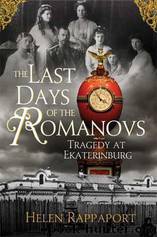Last Days of the Romanovs: Tragedy at Ekaterinburg by Helen Rappaport

Author:Helen Rappaport
Language: eng
Format: mobi, epub
Tags: Non-Fiction, Biography, History
ISBN: 9780312379766
Publisher: St. Martin's Press
Published: 2008-06-05T07:00:00+00:00
In the summer of 1918, the road out to the Koptyaki Forest – a dense area of ancient birch and pine forest nine miles north-west of Ekaterinburg – would take you past the straggling wooden suburbs of the low, flat city, and the stinking smoke stacks of the huge Verkh-Isetsk works, along a small local road that was crossed by the rail lines to Perm and Nizhni-Tagil. After that the going got tough. It certainly wasn’t an easy place to get to by motor vehicle in July 1918 because beyond the crossings the road was little more than a muddy cart track full of puddles and potholes, surrounded by wet, peaty woodland. Nor was there much cause for anyone to wish to go there except to get to the small farming and fishing village of Koptyaki, a collection of wooden peasant huts on the shores of Iset Pond that lay beyond. There was a time when they had mined for gold here – not deep mines but shallow workings, like caves. With 10 or 12 of these old mines located in the area and now overgrown, it was a dangerous place to walk – the open workings were full of fetid silt and rainwater, and beneath that a layer of permafrost. Nevertheless, at 5 p.m. that late summer afternoon of 11 July, a mining technician, Ivan Fesenko, who had been working in the area prospecting for iron ore was idly carving his name and the date of his visit on a tall birch tree. He was sitting not far from a spot known to the locals as the Four Brothers – given its name for four tall pine trees that had once stood there, of which only two stumps remained. Nearby there were a couple of disused iron ore workings, surrounded by mounds of clayey earth, not far from a small pond the locals called Ganina Yama (Ganin’s Pit).
Suddenly Fesenko noticed three men approaching on horseback in the distance. As they came nearer, he recognised one of them immediately as Commandant Yurovsky of the Ipatiev House; the other was a man called Ermakov from the Verkh-Isetsk works; the third man looked to him like an Austrian or Magyar prisoner of war (it was probably Ermakov’s close associate, a former Kronstadt sailor, Stepan Vaganov). Seeing Fesenko, the men stopped and asked him about the state of the road and access to the village of Koptyaki beyond. Could you get a lorry up there? They needed, so they said, to transport ‘500 poods’ (about eight tons) of grain to the village. Fesenko told them he thought the road was good; you could get through by lorry. But as the men turned and rode off, he also asked himself the question: why would they want to transport such a heavy load to such a remote spot?
Back at the Ipatiev House, the guard duty book for that day was filled out, but there seemed nothing to say, except the one recurring comment of late: ‘Vse obychno’; ‘Everything is the same.
Download
Last Days of the Romanovs: Tragedy at Ekaterinburg by Helen Rappaport.epub
This site does not store any files on its server. We only index and link to content provided by other sites. Please contact the content providers to delete copyright contents if any and email us, we'll remove relevant links or contents immediately.
| France | Germany |
| Great Britain | Greece |
| Italy | Rome |
| Russia | Spain & Portugal |
Fanny Burney by Claire Harman(25790)
Empire of the Sikhs by Patwant Singh(22176)
Out of India by Michael Foss(16313)
Leonardo da Vinci by Walter Isaacson(11913)
Small Great Things by Jodi Picoult(6105)
The Six Wives Of Henry VIII (WOMEN IN HISTORY) by Fraser Antonia(4797)
The Wind in My Hair by Masih Alinejad(4427)
The Lonely City by Olivia Laing(4122)
The Crown by Robert Lacey(4111)
A Higher Loyalty: Truth, Lies, and Leadership by James Comey(4038)
The Iron Duke by The Iron Duke(3642)
Millionaire: The Philanderer, Gambler, and Duelist Who Invented Modern Finance by Janet Gleeson(3574)
Sticky Fingers by Joe Hagan(3456)
Alive: The Story of the Andes Survivors by Piers Paul Read(3317)
Papillon (English) by Henri Charrière(3276)
Joan of Arc by Mary Gordon(3263)
Stalin by Stephen Kotkin(3089)
Aleister Crowley: The Biography by Tobias Churton(3024)
Ants Among Elephants by Sujatha Gidla(2927)
